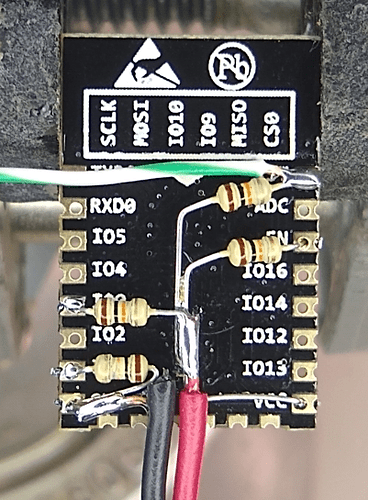Under normal circumstances, this is true. However, in @swegner's case, he doesn't care about two-way communications. So, the delay is not going to hurt anything since his board is going to sleep anyway.
@swegner - I have cleaned up your sketch, simplifying and moving all of your special logic to the bottom of the setup() routine. The loop() routine, in this example will never be called, as it really serves no purpose based on how you're using these microcontrollers with deepSleep().
//******************************************************************************************
// SmartThings Library for ESP8266WiFi
//******************************************************************************************
#include <SmartThingsESP8266WiFi.h>
//******************************************************************************************
// ST_Anything Library
//******************************************************************************************
#include <Constants.h> //Constants.h is designed to be modified by the end user to adjust behavior of the ST_Anything library
#include <Device.h> //Generic Device Class, inherited by Sensor and Executor classes
#include <Sensor.h> //Generic Sensor Class, typically provides data to ST Cloud (e.g. Temperature, Motion, etc...)
#include <Executor.h> //Generic Executor Class, typically receives data from ST Cloud (e.g. Switch)
#include <InterruptSensor.h> //Generic Interrupt "Sensor" Class, waits for change of state on digital input
#include <PollingSensor.h> //Generic Polling "Sensor" Class, polls Arduino pins periodically
#include <Everything.h> //Master Brain of ST_Anything library that ties everything together and performs ST Shield communications
#include <PS_Illuminance.h> //Implements a Polling Sensor (PS) to measure light levels via a photo resistor
#include <PS_TemperatureHumidity.h> //Implements a Polling Sensor (PS) to measure Temperature and Humidity via DHT library
#include <PS_DS18B20_Temperature.h> //Implements a Polling Sesnor (PS) to measure Temperature via DS18B20 libraries
#include <PS_Water.h> //Implements a Polling Sensor (PS) to measure presence of water (i.e. leak detector)
#include <IS_Motion.h> //Implements an Interrupt Sensor (IS) to detect motion via a PIR sensor
#include <IS_Contact.h> //Implements an Interrupt Sensor (IS) to monitor the status of a digital input pin
#include <IS_Smoke.h> //Implements an Interrupt Sensor (IS) to monitor the status of a digital input pin
#include <IS_DoorControl.h> //Implements an Interrupt Sensor (IS) and Executor to monitor the status of a digital input pin and control a digital output pin
#include <IS_Button.h> //Implements an Interrupt Sensor (IS) to monitor the status of a digital input pin for button presses
#include <EX_Switch.h> //Implements an Executor (EX) via a digital output to a relay
#include <EX_Alarm.h> //Implements Executor (EX)as an Alarm Siren capability via a digital output to a relay
#include <S_TimedRelay.h> //Implements a Sensor to control a digital output pin with timing capabilities
//*************************************************************************************************
//NodeMCU v1.0 ESP8266-12e Pin Definitions (makes it much easier as these match the board markings)
//*************************************************************************************************
#define LED_BUILTIN 16
#define BUILTIN_LED 16
//
#define D0 16 //no internal pullup resistor
#define D1 5
#define D2 4
#define D3 0 //must not be pulled low during power on/reset, toggles value during boot
#define D4 2 //must not be pulled low during power on/reset, toggles value during boot
#define D5 14
#define D6 12
#define D7 13
#define D8 15 //must not be pulled high during power on/reset
//******************************************************************************************
//Define which Arduino Pins will be used for each device
//******************************************************************************************
//#define PIN_WATER_1 A0 //NodeMCU ESP8266 only has one Analog Input Pin 'A0'
//#define PIN_ALARM_1 D0 //SmartThings Capabilty "Alarm"
//#define PIN_SWITCH_1 D1 //SmartThings Capability "Switch"
#define PIN_CONTACT_1 D2 //SmartThings Capabilty "Contact Sensor"
//#define PIN_BUTTON_1 D3 //SmartThings Capabilty Button / Holdable Button (Normally Open!)
//#define PIN_BUTTON_2 D4 //SmartThings Capabilty Button / Holdable Button (Normally Open!)
//#define PIN_MOTION_1 D5 //SmartThings Capabilty "Motion Sensor" (HC-SR501 PIR Sensor)
//#define PIN_SMOKE_1 D6 //SmartThings Capabilty "Smoke Detector"
//#define PIN_TEMPERATURE_1 D7 //SmartThings Capabilty "Temperature Measurement" (Dallas Semiconductor DS18B20)
//#define PIN_TIMEDRELAY_1 D8 //SmartThings Capability "Relay Switch"
//******************************************************************************************
//ESP8266 WiFi Information
//******************************************************************************************
String str_ssid = "xxxx"; // <---You must edit this line!
String str_password = ""; // <---You must edit this line!
IPAddress ip(10, 0, 1, 51); //Device IP Address // <---You must edit this line!
IPAddress gateway(10, 0, 1, 1); //Router gateway // <---You must edit this line!
IPAddress subnet(255, 255, 255, 0); //LAN subnet mask // <---You must edit this line!
IPAddress dnsserver(10, 0, 1, 1); //DNS server // <---You must edit this line!
const unsigned int serverPort = 8090; // port to run the http server on
// Hubitat Hub Information
IPAddress hubIp(10, 0, 1, 20); // hubitat hub ip // <---You must edit this line!
const unsigned int hubPort = 39501; // hubitat hub port
//******************************************************************************************
//st::Everything::callOnMsgSend() optional callback routine. This is a sniffer to monitor
// data being sent to ST. This allows a user to act on data changes locally within the
// Arduino sktech.
//******************************************************************************************
void callback(const String &msg)
{
Serial.println("UNIT IS: ESP UNIT 5 Upstairs heat");
Serial.print(F("ST_Anything Callback: Sniffed data = "));
Serial.println(msg);
}
//******************************************************************************************
//Arduino Setup() routine
//******************************************************************************************
void setup()
{
//Interrupt Sensors
static st::IS_Contact sensor1(F("contact1"), PIN_CONTACT_1, LOW, true);
//*****************************************************************************
// Configure debug print output from each main class
// -Note: Set these to "false" if using Hardware Serial on pins 0 & 1
// to prevent communication conflicts with the ST Shield communications
//*****************************************************************************
st::Everything::debug=true;
st::Executor::debug=true;
st::Device::debug=true;
st::PollingSensor::debug=true;
st::InterruptSensor::debug=true;
//*****************************************************************************
//Initialize the "Everything" Class
//*****************************************************************************
//Initialize the optional local callback routine (safe to comment out if not desired)
st::Everything::callOnMsgSend = callback;
//Create the SmartThings ESP8266WiFi Communications Object
//STATIC IP Assignment - Recommended
st::Everything::SmartThing = new st::SmartThingsESP8266WiFi(str_ssid, str_password, ip, gateway, subnet, dnsserver, serverPort, hubIp, hubPort, st::receiveSmartString);
//DHCP IP Assigment - Must set your router's DHCP server to provice a static IP address for this device's MAC address
//st::Everything::SmartThing = new st::SmartThingsESP8266WiFi(str_ssid, str_password, serverPort, hubIp, hubPort, st::receiveSmartString);
//Run the Everything class' init() routine which establishes WiFi communications with SmartThings Hub
st::Everything::init();
//*****************************************************************************
//Add each sensor to the "Everything" Class
//*****************************************************************************
st::Everything::addSensor(&sensor1);
//*****************************************************************************
//Add each executor to the "Everything" Class
//*****************************************************************************
// st::Everything::addExecutor(&executor1);
// st::Everything::addExecutor(&executor2);
//*****************************************************************************
//Initialize each of the devices which were added to the Everything Class
//*****************************************************************************
st::Everything::initDevices();
// pause for a moment
delay (250);
String payload = "contact1 closed";
st::Everything::sendSmartStringNow(payload);
// go to sleep until the reset button is pressed and the unit toggle the contact again.
ESP.deepSleep(0);
}
//******************************************************************************************
//Arduino Loop() routine
//******************************************************************************************
void loop()
{
//*****************************************************************************
//Execute the Everything run method which takes care of "Everything"
//*****************************************************************************
st::Everything::run();
}



